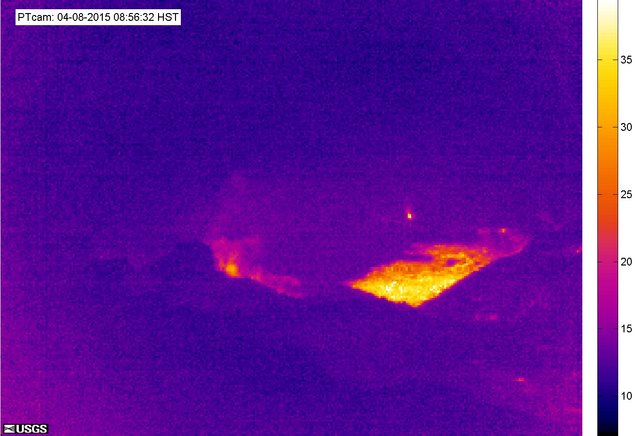One of five vents on Kilauea Volcano’s Puu Oo crater floor erupted a small lava flow Tuesday afternoon, scientists tell West Hawaii Today. ADVERTISING One of five vents on Kilauea Volcano’s Puu Oo crater floor erupted a small lava flow
One of five vents on Kilauea Volcano’s Puu Oo crater floor erupted a small lava flow Tuesday afternoon, scientists tell West Hawaii Today.
The flow, which remained active Wednesday, is contained within the crater, said Tim Orr, a geologist with the U.S. Geological Survey Hawaiian Volcano Observatory.
Tuesday’s eruption occurred about 5 p.m. and was “short-lived,” lasting no more than 30 minutes, he said. The eruption sent lava from the vent down into a “slightly deeper center” of the crater.
Orr said such eruptions are common at Puu Oo, which has hosted small vents for several decades. Those vents serve as the “source of outgassing, incandescence and sometimes lava flows — and the current crater is no exception,” he explained.
“It’s just standard behavior, we see these things commonly. But this one was a little bit larger,” Orr said. He also noted the eruptions occur time and time again but are not mentioned in the observatory’s daily eruption update.
Such eruptions are more likely during the inflation period of the volcano’s deflation-inflation cycle, Orr said. During inflation, magma rises into the summit reservoir, according to the observatory. The summit reservoir enters the deflation portion of the cycle when the magma moves laterally into a rift zone and either erupts or is stored there.
While Kilauea Volcano remained inflated Tuesday, the deflation-inflation cycle had already ceased, Orr said. Tiltmeters positioned at Kilauea’s summit continued to record slow inflation Wednesday.
“Right now we’re not in a D-I event, we’ve gone through it,”he said. Kilauea is “just in an inflated state, a background inflated state.”
The eruption on the south edge of the crater floor on Tuesday follows a sizable collapse of the crater flow on its western edge, Orr said. The event occurred sometinme between aieral overflights of Puu Oo conducted on March 24 and Friday. Scientists are unable to narrow the time frame further because the collapse occurred outside the purview of cameras on the crater’s north rim.
The collapse resulted in a visible lava lake that measured more than 121 feet across, Orr said, noting that a lava pond has probably been in the area for some time but “conditions were finally reight for part of the roof to collapse.”
Meanwhile, three areas of breakouts remained active Wednesday in the upslope portion of the June 27 lava flow, the scientists said. All of the breakouts are located within 4 miles of the Puu Oo vent.
There are no other areas of breakouts along the June 27 flow field located within Kilauea Volcano’s East Rift Zone. All downslope areas remained quiet.
Kileauea Volcano’s summit caledera continues to host a lava lake, Orr said Wednesday. On Tuesday, the lake level reached to 33 feet below the rim of Halemaumau Crater.
Tiltmeters at the summit continued to record slow inflation. Seismic tremor continued at the summit with episodic bursts accompanying spattering and temporary drops in lava level. Earthquake activity remained slightly elevated beneath the south caldera and in the Southwest Rift Zone midway between the summit caldera and the ocean.
The U.S. Geological Survey Hawaiian Volcano Observatory on March 25 downgraded its alert level for Kilauea Volcano from a warning to a watch.
The observatory said the decision to lower the alert level from “warning” to “watch” was made because the lava flow nearest to the town of Pahoa has remained inactive. Hawaii County Civil Defense on March 28 suspended its daily eruption and lava flow updates.






